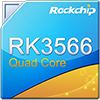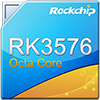With the rapid development of AI, large-scale models such as GPT, Deepseek, DALL·E, and Stable Diffusion have revolutionized industries ranging from natural language processing to computer vision. These models, however, often require massive cloud-based infrastructure, leading to challenges in latency, cost, and privacy. As a result, edge AI inference—running AI models directly on edge devices—has emerged as a critical solution for real-time applications. This shift enables faster response times, reduced dependence on cloud computing, and enhanced data security. Rockchip&Allwinner, as leader in embedded AI solutions, offers powerful SoCs such as R128, R528, PX30, RK3566, and RK3576, which provide an ideal balance of power efficiency, cost, computing performance, and AI processing capabilities. We will explore how Rocktech leverages these SoCs to provide high-performance SBC solutions for edge AI applications.
Edge AI Topology Architecture
Edge AI architectures can be categorized into two types:
1. Data Collection & Cloud-based Inference
In this architecture, edge devices only collect data or process simple commands, while the server handles all AI inference tasks. The results are then transmitted back to the edge device for execution.
- Advantages: The SoCs on the edge side do not require AI inference capabilities, significantly reducing hardware costs. Devices like Allwinner R128, R528, and Rockchip PX30 are sufficient for this type of deployment.
- Use Cases: Smart sensors, IoT monitoring, basic image/video streaming, cloud-based AI analytics.
- Workflow:
- Sensors and devices collect raw data (e.g., video feeds, environmental data).
- Data is transmitted to a remote cloud or on-premises AI server.
- The AI model processes the data and generates results.
- The server sends back processed information or control signals to the edge device.
2. Local AI Inference with Cloud Optimization
In this architecture, the server trains a large AI model and then distills a lightweight model that runs directly on the edge device. This approach requires edge devices to have certain AI inference capabilities. The edge device can also send feedback to the server to further refine the AI model over time.
- Advantages: Reduces dependence on cloud computing, enables real-time AI decisions, and allows continuous model improvements. SoCs like Rockchip RK3566, RK3576, and RK3588 can efficiently run AI inference on the edge.
- Use Cases: Smart surveillance, robotics, real-time object detection, AI-enhanced user interfaces, autonomous vehicles.
- Workflow:
- The server trains a deep learning model and distills a lightweight version for deployment on the edge device.
- The edge device runs AI inference locally without relying on the cloud.
- The edge device processes real-time data and makes intelligent decisions.
- Edge device feedback (new data, errors, optimizations) is sent back to the server for continuous model refinement.
Applications of Edge AI
Edge AI is increasingly being adopted across various industries, enabling intelligent processing without relying on cloud servers. Some of the key applications include:
- Smart Surveillance & Security: AI-powered cameras can perform real-time facial recognition, motion detection, and anomaly detection for security systems.
- Industrial Automation: Edge AI enables predictive maintenance, defect detection, and process optimization in manufacturing lines.
- Autonomous Vehicles & Smart Transportation: AI algorithms running on edge devices process sensor data for autonomous navigation, traffic monitoring, and fleet management.
- Smart Retail: AI-driven customer behavior analysis, cashier-less checkout systems, and personalized advertising enhance the shopping experience.
- Medical & Healthcare: Edge AI assists in medical imaging analysis, remote patient monitoring, and early disease detection without relying on cloud processing.
- AIoT (Artificial Intelligence of Things): Smart home devices, wearables, and industrial IoT applications leverage Edge AI for localized decision-making and automation.
- Robotics & Drones: AI-powered robots and drones use real-time computer vision and decision-making for navigation, object recognition, and autonomous operations.
Rocktech’s Expertise in Edge AI Solutions
Rocktech specializes in designing and manufacturing Single Board Computers (SBCs) based on Rockchip, Allwinner, and other SoCs for various applications. With extensive experience in embedded computing, Rocktech provides customized hardware and software solutions(including ATOS, Linux, Android ) for edge AI applications, including industrial automation, smart surveillance, and AI-driven IoT devices. By leveraging Rockchip’s powerful SoCs, Rocktech ensures optimized AI inference performance, delivering reliable and efficient edge computing solutions tailored to customer needs.
Overview of SoCs
Allwinner R128
- CPU: 64-bit RISC-V core

- Memory: 1MB SRAM, up to 16MB flash, up to 32MB PSRAM
- OS: ATOS
- Use Cases: Low-power AI edge computing, smart home devices
Allwinner R528
- CPU: Dual-core Cortex-A7
- Memory: 128MB DDR3
- OS: Linux Buildroot
- Use Cases: Embedded AI systems, industrial automation
Rockchip PX30
- CPU: Quad-core Cortex-A35

- NPU: No dedicated NPU, optimized CPU/GPU AI acceleration
- Memory: LPDDR4/DDR3
- OS: Android 11/Linux Buildroot
- Use Cases: AI-enhanced automotive applications, smart displays
Rockchip RK3566
- CPU: Quad-core Cortex-A55

- GPU: Mali-G52 1EE
- NPU: Up to 1 TOPS AI performance
- Memory: LPDDR4/LPDDR4X/DDR4 support
- OS: Android 11/ Linux Buildroot/ Linux Yocto/ Linux Debian
- Use Cases: AI-assisted vision processing, smart IoT devices
Rockchip RK3576
- CPU: Quad-core Cortex-A76 + Cortex-A55

- GPU: Mali-G57
- NPU: 6 TOPS AI performance
- Memory: LPDDR5/LPDDR4X
- OS: Android 14
- Use Cases: Edge AI processing, embedded robotics, intelligent surveillance
Multiple Communication Interfaces of SBCs
Rocktech’s SBCs are designed to support a variety of communication interfaces, making them ideal for diverse edge AI applications. These include:
- Ethernet : Ensures high-speed data transmission for internet networke.
- Wi-Fi & Bluetooth: Enables fast and stable wireless connectivity.
- 4G/5G Modules: Supports cellular connectivity for remote Internet.
- HDMI, MIPI-DSI, LVDS, RGB, EDG: Supports diverse display outputs for vision-based applications.
- RS485 & CAN Bus: Enables reliable industrial communication for automation and control systems.
- I2C & Camera Interfaces: Supports various sensor and imaging applications, crucial for AI vision and robotics.
- ZigBee & Other IoT Protocols: Facilitates seamless integration into IoT networks for smart applications.
By integrating these interfaces, Rocktech ensures that its SBCs can handle diverse industrial, commercial, and AI-driven applications with ease.
You can customize SBC based on your requirements.




